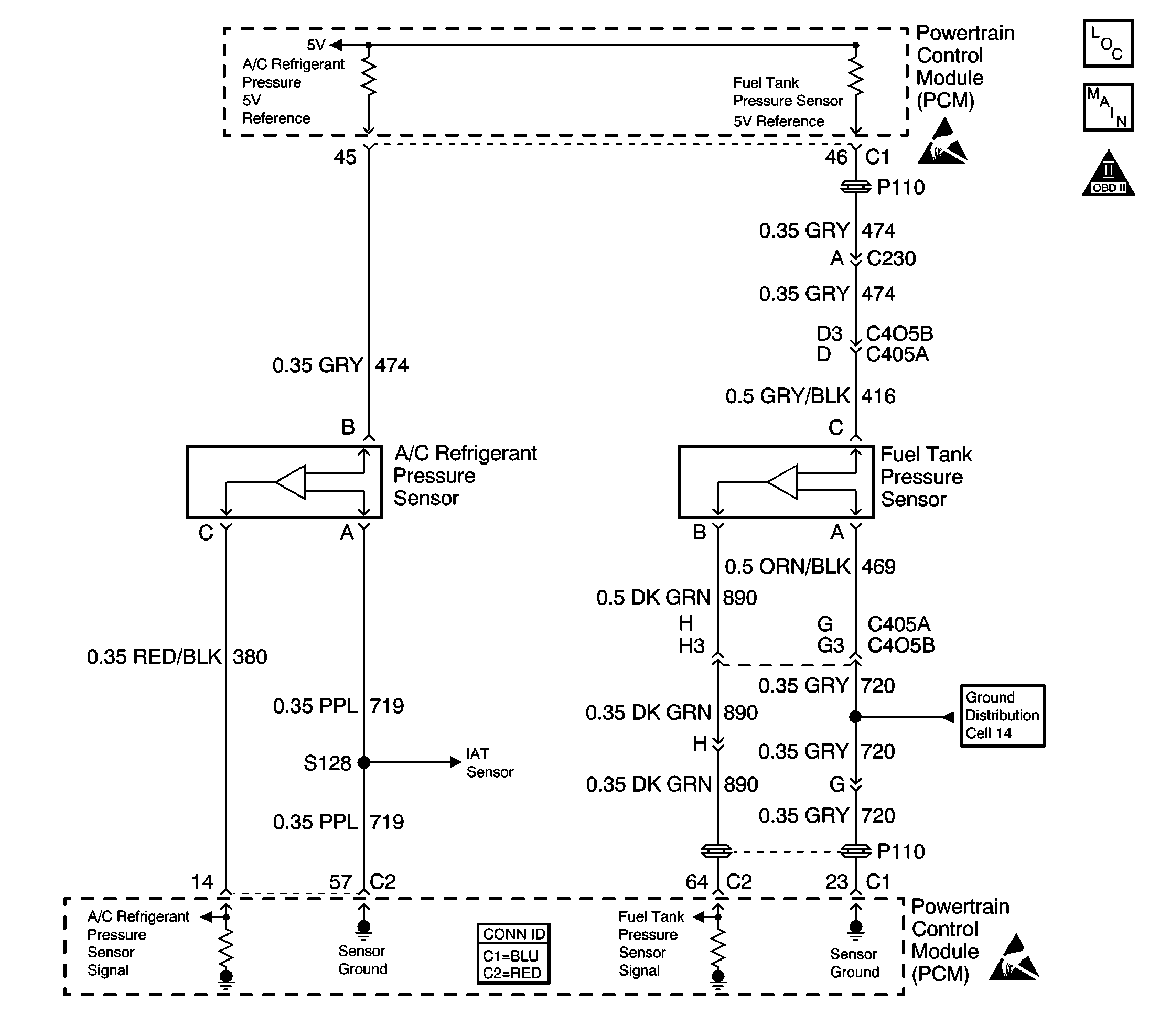
Circuit Description
The PCM uses a common 5.0 volt reference circuit as a sensor feed to the Fuel Tank Pressure sensor and the A/C Refrigerant Pressure sensor.
The PCM monitors the voltage on the 5.0 volt reference circuit. This DTC sets if the voltage is out of range.
Conditions for Running the DTC
The engine operating.
Conditions for Setting the DTC
| • | The 5.0 volt reference circuit is out of range. |
| • | The above condition is present for more than 2 seconds. |
Action Taken When the DTC Sets
| • | The PCM illuminates the malfunction indicator lamp (MIL) on the second consecutive ignition cycle that the diagnostic runs and fails. |
| • | The PCM records the operating conditions at the time the diagnostic fails. The first time the diagnostic fails, the PCM stores this information in the Failure Records. If the diagnostic reports a failure on the second consecutive ignition cycle, the PCM records the operating conditions at the time of the failure. The PCM writes the conditions to the Freeze Frame and updates the Failure Records. |
Conditions for Clearing the MIL/DTC
| • | The PCM turns OFF the malfunction indicator lamp (MIL) after 3 consecutive ignition cycles that the diagnostic runs and does not fail. |
| • | A last test failed, or current DTC, clears when the diagnostic runs and does not fail. |
| • | A history DTC clears after 40 consecutive warm-up cycles, if no failures are reported by this or any other emission related diagnostic. |
| • | Use a scan tool in order to clear the MIL and the DTC. |
Diagnostic Aids
Important:
• Remove any debris from the PCM connector surfaces before servicing
the PCM. Inspect the PCM connector gaskets when diagnosing/replacing
the PCM. Ensure that the gaskets are installed correctly. The gaskets
prevent water intrusion into the PCM. • For any test that requires probing the PCM or component harness
connectors, use the J 35616
connector test adapter kit. Using this kit prevents damage to the
harness connector terminals. Refer to
Using Connector Test Adapters
in Wiring Systems.
A fuel level sensor signal circuit that is shorted to B+ may set this DTC.
If no circuit conditions can be found, test the affected component.
For an intermittent condition, refer to Symptoms .
Test Description
The numbers below refer to the step numbers on the diagnostic table.
-
The 5 volt reference circuits for the sensors are connected together inside the PCM. Both DTCs P1635 and P1639 set at the same time, indicates a 5 volt reference circuit is shorted to a voltage.
-
This step determines if a 5 volt reference circuit is shorted to ground.
-
This step tests for a signal circuit shorted to voltage.
-
The 5 volt reference circuits may be shorted to another PCM circuit. The shorted circuit may not be apparent when the PCM harness connector is disconnected. Testing continuity from each 5 volt reference circuit isolates the shorted circuit.
-
This step is testing for a component failure. Disconnecting each component individually isolates which component might be causing this DTC to set.
Step | Action | Value(s) | Yes | No | ||||||||||||
|---|---|---|---|---|---|---|---|---|---|---|---|---|---|---|---|---|
1 | Did you perform the Powertrain On-Board Diagnostic (OBD) System Check? | -- | ||||||||||||||
Did both DTCs P1635 and P1639 fail this ignition? | -- | |||||||||||||||
3 | Did DTC P1639 fail this ignition? | -- | ||||||||||||||
4 |
Does the scan tool indicate the DTC set this ignition? | -- | Go to Diagnostic Aids | |||||||||||||
Does the test lamp illuminate for any of the circuits? | -- | |||||||||||||||
Does the test lamp illuminate for any of the circuits? | -- | |||||||||||||||
Test continuity from each 5 volt reference circuit to all other PCM circuits at the PCM harness connector using the DMM. Example: probe one lead to the A/C refrigerant pressure sensor 5 volt reference (at the PCM harness connector) circuit and probe the other lead to each terminal at the PCM harness connector. This must be performed for each 5 volt reference circuit. Refer to Testing for Continuity in Wiring Systems. Do any of the circuits indicate a resistance within the specified range? | 0-2ohms | |||||||||||||||
8 | Repair the short to ground on the appropriate 5 volt reference circuit. Refer to Wiring Repairs in Wiring Systems. Is the action complete? | -- | -- | |||||||||||||
9 | Repair the short to voltage on the appropriate signal circuit. Refer to Wiring Repairs in Wiring Systems. Is the action complete? | -- | -- | |||||||||||||
10 | Repair the short between the appropriate 5 volt reference circuit and the PCM circuit that had continuity. Refer to Wiring Repairs in Wiring Systems. Is the action complete? | -- | -- | |||||||||||||
|
Important: Repeat this procedure for each component.
Does the scan tool indicate that DTC P1635/P1639 passed with the component disconnected? | -- | |||||||||||||||
12 | Replace the component for which the Diagnostic Trouble Code passed. Refer to the appropriate replacement procedure. Is the action complete? | -- | -- | |||||||||||||
13 |
Important:: Program the replacement PCM. Refer to Powertrain Control Module Replacement/Programming . Replace the PCM. Is the action complete? | -- | -- | |||||||||||||
14 |
Does the scan tool indicate that this test ran and passed? | -- | ||||||||||||||
15 | Select the Capture Info option and the Review Info option using the scan tool. Are any DTCs displayed that you have not diagnosed? | -- | Go to the applicable DTC table | System OK |
